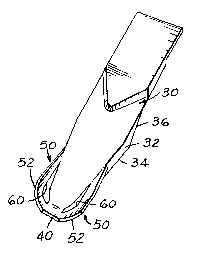Some of the information on this Web page has been provided by external sources. The Government of Canada is not responsible for the accuracy, reliability or currency of the information supplied by external sources. Users wishing to rely upon this information should consult directly with the source of the information. Content provided by external sources is not subject to official languages, privacy and accessibility requirements.
Any discrepancies in the text and image of the Claims and Abstract are due to differing posting times. Text of the Claims and Abstract are posted:
| (12) Patent Application: | (11) CA 2047797 |
|---|---|
| (54) English Title: | CAULK AND GLAZING TOOL |
| (54) French Title: | OUTIL A ETENDRE LE MASTIC ET AUTRES PRODUITS D'ETANCHEITE |
| Status: | Deemed Abandoned and Beyond the Period of Reinstatement - Pending Response to Notice of Disregarded Communication |
| (51) International Patent Classification (IPC): |
|
|---|---|
| (72) Inventors : |
|
| (73) Owners : |
|
| (71) Applicants : | |
| (74) Agent: | MARKS & CLERK |
| (74) Associate agent: | |
| (45) Issued: | |
| (22) Filed Date: | 1991-07-24 |
| (41) Open to Public Inspection: | 1992-01-27 |
| Examination requested: | 1996-10-17 |
| Availability of licence: | N/A |
| Dedicated to the Public: | N/A |
| (25) Language of filing: | English |
| Patent Cooperation Treaty (PCT): | No |
|---|
| (30) Application Priority Data: | ||||||
|---|---|---|---|---|---|---|
|
ABSTRACT OF THE DISCLOSURE
A glazing tool which has a handle plate to be gripped
between the thumb and forefinger of an operator. Two spaced
trim blades have runner edges disposed at an angle to handle
plates to trim the bead of glazing material. These runner edges
angle toward the distal end of the back plate where a bead
contact blade is disposed transversely of the runner edges.
Perforate side wings proximal to the bead contact blade rise
upwardly and outwardly of the trim blades to guide trimmed glaze
material away from the tool.
Note: Claims are shown in the official language in which they were submitted.
Note: Descriptions are shown in the official language in which they were submitted.

2024-08-01:As part of the Next Generation Patents (NGP) transition, the Canadian Patents Database (CPD) now contains a more detailed Event History, which replicates the Event Log of our new back-office solution.
Please note that "Inactive:" events refers to events no longer in use in our new back-office solution.
For a clearer understanding of the status of the application/patent presented on this page, the site Disclaimer , as well as the definitions for Patent , Event History , Maintenance Fee and Payment History should be consulted.
| Description | Date |
|---|---|
| Inactive: IPC from MCD | 2006-03-11 |
| Application Not Reinstated by Deadline | 1999-07-26 |
| Time Limit for Reversal Expired | 1999-07-26 |
| Deemed Abandoned - Failure to Respond to Maintenance Fee Notice | 1998-07-24 |
| Letter Sent | 1997-10-03 |
| Reinstatement Requirements Deemed Compliant for All Abandonment Reasons | 1997-09-08 |
| Deemed Abandoned - Failure to Respond to Maintenance Fee Notice | 1997-07-24 |
| Request for Examination Requirements Determined Compliant | 1996-10-17 |
| All Requirements for Examination Determined Compliant | 1996-10-17 |
| Application Published (Open to Public Inspection) | 1992-01-27 |
| Abandonment Date | Reason | Reinstatement Date |
|---|---|---|
| 1998-07-24 | ||
| 1997-07-24 |
The last payment was received on 1997-09-08
Note : If the full payment has not been received on or before the date indicated, a further fee may be required which may be one of the following
Please refer to the CIPO Patent Fees web page to see all current fee amounts.
| Fee Type | Anniversary Year | Due Date | Paid Date |
|---|---|---|---|
| Reinstatement | 1997-09-08 | ||
| MF (application, 6th anniv.) - small | 06 | 1997-07-24 | 1997-09-08 |
Note: Records showing the ownership history in alphabetical order.
| Current Owners on Record |
|---|
| GUY N. LEMASTER |
| Past Owners on Record |
|---|
| None |